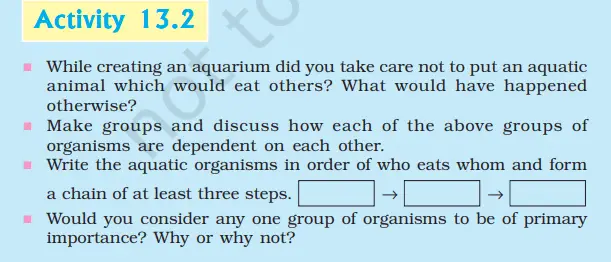Activity 13.2 Class 10 Science Our Environment
Activity 13.2 Class 10 Science of NCERT book encourages students to understand the dynamics of an aquatic ecosystem. It asks them to consider the implications of introducing predatory species into an aquarium, discuss the interdependence of organisms, construct a food chain, and reflect on the importance of different groups of organisms in the ecosystem.

Exploring aquatic ecosystem dynamics and Interdependencies
Aim of Activity 13.2 Class 10 Science
The aim of this activity is to understand the interdependence of organisms in an aquatic ecosystem and to construct a simple food chain.
The solutions to all of the questions of activity 13.2 class 10 science that were expected to be addressed in the group among students are provided below.
Our Environment Activity 13.2 Questions and Answers
While creating an aquarium did you take care not to put an aquatic animal that would eat others? What would have happened otherwise?
In an aquarium, it’s important to ensure that the species coexisting are compatible and won’t harm each other. If a predatory aquatic animal that eats others is introduced, it could disrupt the balance, leading to the loss of other species in the aquarium.
Make groups and discuss how each of the above groups of organisms is dependent on each other.
In an aquatic ecosystem, small fish eat phytoplankton and aquatic plants, controlling their overgrowth. These small fish, in turn, serve as food for larger fish. This predator-prey relationship ensures a balance in the ecosystem, with each organism playing a role in maintaining the overall health and biodiversity of the environment. The energy flows from plants to small fish and then to large fish, illustrating the food chain.
Write the aquatic organisms in order of who eats whom and form a chain of at least three steps. step 1 ? step 2 ? step 3
This is asking for a simple food chain. An example could be:
Algae (step 1, producer) ? Small Fish (step 2, primary consumer) ? Large Fish (step 3, secondary consumer).
Would you consider any one group of organisms to be of primary importance? Why or why not?
All organisms in an ecosystem have their role and importance. However, producers (like plants or algae in an aquatic ecosystem) can be considered of primary importance as they form the base of the food chain by converting sunlight into energy through photosynthesis, which is then used by all other organisms.
Interdependence of Predatory and Prey Organisms in an Aquatic Ecosystem
In an aquatic ecosystem, the relationship between predatory organisms and their prey is a fundamental part of the food chain and overall ecosystem dynamics. Here’s how they depend on each other:
- Energy Transfer: Predators depend on their prey as a source of food, which provides them with the energy they need to survive, grow, and reproduce. This energy is originally derived from the sun and is converted into a usable form through photosynthesis by primary producers (like algae or phytoplankton). Herbivorous organisms (the prey) eat these primary producers and convert this energy into a form that can be used by predatory organisms when they consume the prey.
- Population Control: Predators help control the population of their prey species. Without predators, prey populations could grow to unsustainable levels and potentially exhaust their food resources, leading to a collapse of the population. Conversely, the presence of prey influences the population of predators. If prey is scarce, the predator population may decrease due to starvation.
- Biodiversity and Ecosystem Health: The predator-prey relationship contributes to the biodiversity of an ecosystem. It helps in maintaining the balance of different species. A healthy ecosystem needs a good balance of predators and prey to maintain its complexity and diversity.
- Evolution and Adaptation: The predator-prey relationship drives evolution and adaptation. Prey species may evolve specific traits to avoid predation (like camouflage or fast swimming speeds), and predators may correspondingly evolve to better catch their prey (like improved senses or stealth).
Remember, these relationships form complex food webs, not just simple chains, as many organisms have multiple prey and predators, and changes to one species can have cascading effects throughout the ecosystem.